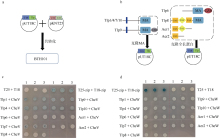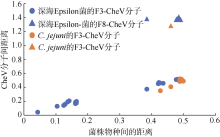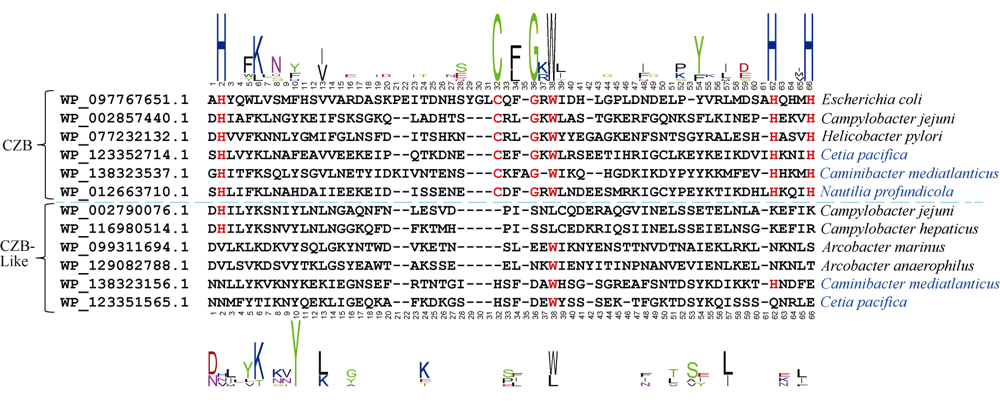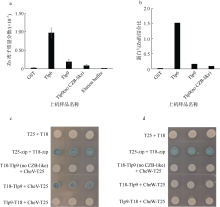热带海洋学报 ›› 2021, Vol. 40 ›› Issue (2): 27-38.doi: 10.11978/2020055CSTR: 32234.14.2020055
Epsilon-变形菌趋化信号通路中偶联蛋白CheV与趋化受体蛋白的CZB结构域的功能研究
刘煜耿1,2( ), 毛颖津1,2, 章灿川1,2, 高贝乐1(
), 毛颖津1,2, 章灿川1,2, 高贝乐1( )
)
- 1.中国科学院热带海洋生物资源与生态重点实验室, 广东省海洋药物重点实验室, 中国科学院南海海洋研究所, 广东 广州 510301
2.中国科学院大学, 北京 100049
-
收稿日期:2020-05-26修回日期:2020-06-29出版日期:2021-03-10发布日期:2020-07-29 -
通讯作者:高贝乐 -
作者简介:刘煜耿(1994—), 男, 广东省揭阳市人, 硕士研究生, 研究方向为微生物功能基因组学。email:yugengliu@163.com -
基金资助:国家自然科学基金(31870064)
Functional study of coupling protein CheV and CZB domain of chemoreceptors in the Epsilon-proteobacteria chemotaxis signaling pathway
LIU Yugeng1,2( ), MAO Yingjin1,2, ZHANG Canchuan1,2, GAO Beile1(
), MAO Yingjin1,2, ZHANG Canchuan1,2, GAO Beile1( )
)
- 1. CAS Key Laboratory of Tropical Marine Bio-resources and Ecology, Guangdong Key Laboratory of Marine Materia Medica, South China Sea Institute of Oceanology, Chinese Academy of Sciences, Guangzhou 510301, China
2. University of Chinese Academy of Sciences, Beijing 100049, China
-
Received:2020-05-26Revised:2020-06-29Online:2021-03-10Published:2020-07-29 -
Contact:GAO Beile -
Supported by:National Science Foundation of China(31870064)
摘要:
细菌通过趋化系统感知和响应外界环境变化并进行趋利避害, 因此很多细菌进化出了非常复杂多样的趋化系统以适应不同的生态位。Epsilon-变形菌广泛存在于自然界中, 能适应不同的生态环境, 特别是深海Epsilon-变形菌能适应深海热液口和冷泉等极端环境, 其趋化系统可能有其独特之处。通过BlastP和MIST数据库分析, 我们发现大部分深海Epsilon-变形菌拥有F3类型趋化系统且具有单拷贝的双功能域融合蛋白CheV。此外, 一种特殊结构域CZB (C-terminal Zinc-Binding) 存在于深海Epsilon-变形菌的趋化受体蛋白中, 而且在部分深海Epsilon-变形菌的趋化受体中还发现并鉴定了一种新的结构域CZB-like结构域。文章以Epsilon-变形菌的模式菌株空肠弯曲杆菌(Campylobacter jejuni 81-176)为研究对象, 用细菌双杂交试验证实了CheV能与所有含MA结构域的趋化受体相互作用。用电感耦合等离子体质谱(ICP-Mass)技术证实了CZB-like结构域不能结合Zn离子, 但细菌双杂交试验证实它能介导趋化受体Tlp9与CheV的互作。
中图分类号:
- P735.4
引用本文
刘煜耿, 毛颖津, 章灿川, 高贝乐. Epsilon-变形菌趋化信号通路中偶联蛋白CheV与趋化受体蛋白的CZB结构域的功能研究[J]. 热带海洋学报, 2021, 40(2): 27-38.
LIU Yugeng, MAO Yingjin, ZHANG Canchuan, GAO Beile. Functional study of coupling protein CheV and CZB domain of chemoreceptors in the Epsilon-proteobacteria chemotaxis signaling pathway[J]. Journal of Tropical Oceanography, 2021, 40(2): 27-38.
表1
菌株信息"
| 物种名称 | 菌株 | 生物样品序列号 | 生物项目序列号 | 基因组编号 | 纯培养 | 呼吸类型 | 参考文献 |
|---|---|---|---|---|---|---|---|
| Caminibacter mediatlanticus | TB-2 | SAMN10884411 | PRJNA521379 | GCA_006459125.1 | 是 | 厌氧 | |
| Cetia pacifica | TB6 | SAMN03737945 | PRJNA284962 | GCA_003346815.1 | 是 | 厌氧 | |
| Hydrogenimonas sp. | MAG | SAMN00210774 | PRJNA543187 | GCA_005886055.1 | 否 | 兼性厌氧 | |
| Lebetimonas sp.# | JS138 | SAMN03737948 | PRJNA66817 | GCA_003660105.1 | 否 | 厌氧 | |
| Nautilia profundicola | AmH | SAMN03737951 | PRJNA284966 | GCA_003544915.1 | 是 | 厌氧 | |
| Nautilia sp. | PV-1 | SAMN03737952 | PRJNA284967 | GCA_003346755.1 | 是 | 厌氧 | |
| Nitratiruptor sp. | SB155-2 | SAMN03737954 | PRJNA66821 | GCA_003544935.1 | 是 | 兼性厌氧 | |
| Sulfurimonas autotrophica | DSM 16294 | SAMN03737955 | PRJNA66823 | GCA_003346775.1 | 是 | 好氧 | |
| Campylobacter jejuni* | 81-176 | SAMEA4030738 | PRJEB6403 | GCA_900637395.1 | 是 | 微好氧 |
表3
Campylobacter jejuni 81-176相关基因信息"
| 基因 | 基因编号 | 蛋白结构域示意图 |
|---|---|---|
| cheV | CJJ81176_0311 |  |
| cheW | CJJ81176_0309 |  |
| tlp1 | CJJ81176_1498 |  |
| tlp2 | CJJ81176_0180 |  |
| tlp3# | CJJ81176_1548 |  |
| tlp3# | CJJ81176_1549 |  |
| tlp4 | CJJ81176_0289 |  |
| tlp5* | CJJ81176_0271-4 | Pseudogene |
| tlp6 | CJJ81176_0473 |  |
| tlp7 | CJJ81176_0975 |  |
| tlp8 | CJJ81176_1128 |  |
| tlp9 | CJJ81176_1205 |  |
| tlp10 | CJJ81176_0046 |  |
| aer1 | CJJ81176_1204 |  |
| aer2 | CJJ81176_1206 |  |
表4
引物序列"
| 引物名称 | 序列(5’→ 3’) |
|---|---|
| pKNT25+cheV_F | CTCTAGAGGATCCCCGGGTAATGTTTGATGAAAATATCGT |
| pKNT25+cheV_R | GTCATTGAATTCGAGCTCGGTTACCCCTGTTCTTGAGATT |
| pKNT25+cheW_F | CAGGTCGACTCTAGAGGATCCCCGGGTAATGAGTAATGAAAAATTAGAGCAAATTTTGC |
| pKNT25+cheW_R | CTGCATGGTCATTGAATTCGAGCTCGGAAATTCGCGCTTAAGTAAAGCTTCTACTTTG |
| pUT18C+tlp1_F | ACTGCAGGTCGACTCTAGATGAAATTAAAAAGATGCTTTTGGCTT |
| pUT18C+tlp1_R | ATATCGATGAATTGCTCGAGTTAAAATCTTTTTTTACTCACATCTTCAAG |
| pUT18C+tlp4_F | ACGCCACTGCAGGTCGACTCTAGATCTCTCCCCACTTGCAGCTATCCAAACAGGT |
| pUT18C+tlp4_R | TAGTTATATCGATGAATTGCTCGAGTTAAAACCTTTTCTTCTTAACATCTTCTAA |
| pUT18C+tlp6_F | ACGCCACTGCAGGTCGACTCTAGATATGTTTGGAAGTAAAATAAACCATTCTGAT |
| pUT18C+tlp6_R | TAGTTATATCGATGAATTGCTCGAGTTAATGATCTGACTCATCAAGCATTTCTTT |
| pUT18C+tlp7_F | ACTGCAGGTCGACTCTAGATCAATTTATCGAAAAAACTCATAAGGCAGTT |
| pUT18C+tlp7_R | ATATCGATGAATTGCTCGAGTTAAATTTGAAATTGGTTAAGTTCGCTTTC |
| pUT18C+tlp8_F | ACGCCACTGCAGGTCGACTCTAGATATGTTTGGTGCTAAGAAAAATAATACTGAA |
| pUT18C+tlp8_R | TAGTTATATCGATGAATTGCTCGAGTTATGACATCGCTTTAGCAACTTCAGCAGAGCT |
| pUT18C+tlp9_F | ACGCCACTGCAGGTCGACTCTAGATTTAGCAAACATAGAAGTGACAGCAAGATCT |
| pUT18C+tlp9_R | TAGTTATATCGATGAATTGCTCGAGTTATATTTTTAATTTTGCTAAGATTTCAGC |
| pUT18C+tlp10_F | ACTGCAGGTCGACTCTAGATTCAAGTCATCAAAATTCACAAAAACTCAA |
| pUT18C+tlp10_R | ATATCGATGAATTGCTCGAGTTACTGAAAGCTACTTAATTTTTCGGAGAG |
| pUT18C+aer1_F | ACTGCAGGTCGACTCTAGATAAAGAAATAGTTTTGTCTGAAAATGCTTTA |
| pUT18C+aer1_R | ATATCGATGAATTGCTCGAGTTAATTATTTTCTTGTAAGTTAAAAATAAGTTCAT |
| pUT18C+aer2_F | ACTGCAGGTCGACTCTAGATTCAAGAGAAATTTTTTTACAAGAAGATAGT |
| pUT18C+aer2_R | ATATCGATGAATTGCTCGAGTTATTTAGCTTCTTGAAGAGAAAAGATTAGC |
| pUT18C+tlp9 (no CZB-like)_F | ACTGCAGGTCGACTCTAGATTTAGCAAACATAGAAGTGACAGCAAGATCT |
| pUT18C+tlp9 (no CZB-like)_R | ATATCGATGAATTGCTCGAGTTAATAAAGAATATGATCGATTTTAACCAC |
| pCH363+tlp9_F | ACAGCTATGACCATGATTACGCCATTAGCAAACATAGAAGTGACAGCAAGATCT |
| pCH363+tlp9_R | TGGCCTCGCTGGCGGCTGAATTCGATATTTTTAATTTTGCTAAGATTTCAGCACT |
| pGEX-6P+tlp6_F | TCTGTTCCAGGGGCCCCTGGGATCCTTGCTTAGACAACACAAAGATGAGC |
| pGEX-6P+tlp6_R | GCTCGAGTCGACCCGGGAATTCCGGTTATATTTTTAATTTTGCTAAGATTTCAGCAC |
| pGEX-6P+tlp9_F | TCTGTTCCAGGGGCCCCTGGGATCCATGTTTGGAAGTAAAATAAACCATTCTGATCTTC |
| pGEX-6P+tlp9_R | GCTCGAGTCGACCCGGGAATTCCGGTTAATGATCTGACTCATCAAGCATTTC |
| pGEX-6P+tlp9 (no CZB-like)_F | TCTGTTCCAGGGGCCCCTGGGATCCATGTTTGGAAGTAAAATAAACCATTCTGATCTTC |
| pGEX-6P+tlp9 (no CZB-like)_R | GCTCGAGTCGACCCGGGAATTCCGGTTAATCGATTTTAACCACAGACAAAATCAATC |
表5
深海Epsilon-变形菌的F类型和CheV的分析统计"
| 菌株 | F类型 | CheV蛋白编号 | 菌株 | F类型 | CheV蛋白编号 |
|---|---|---|---|---|---|
| Campylobacter jejuni* | 1 (F3) | WP_002857365.1 | Nautilia profundicola | 1 (F3) | WP_041361491.1 |
| Caminibacter mediatlanticus | 1 (F3) | WP_007474092.1 | Nautilia sp. PV-1 | 1 (F3) | WP_127679461.1 |
| Cetia pacifica | 1 (F3) | WP_123351600.1 | Nitratiruptor sp. SB155-2 | 1 (F14) | WP_012081979.1 |
| Hydrogenimonas sp. MAG | 1 (F3) | BBG65199.1 | Sulfurimonas autotrophica | 2 (F3/F8) | WP_013326429.1 WP_013327173.1# |
| Lebetimonas sp. JS138 | 1 (F3) | WP_024787070.1 |
表6
深海Epsilon-变形菌CZB结构域的分析统计"
| 菌株 | CZB个数 | 含CZB的蛋白编号 | CZB-like个数 | 含CZB-like的蛋白编号 |
|---|---|---|---|---|
| Campylobacter jejuni* | 1 | WP_002857440.1 | 1 | WP_002790076.1 |
| Caminibacter mediatlanticus | 2 | WP_138323537.1, WP_138323100.1 | 1 | WP_138323156.1 |
| Cetia pacifica | 2 | WP_123352714.1, WP_123352123.1 | 1 | WP_123351565.1 |
| Hydrogenimonas sp. MAG | 5 | BBG65387.1, BBG65955.1, BBG65459.1, BBG65926.1, BBG65424.1 | 0 | 0 |
| Lebetimonas sp. JS138 | 1 | WP_024791915.1 | 0 | 0 |
| Nautilia profundicola | 2 | WP_012663710.1, WP_015902667.1 | 0 | 0 |
| Nautilia sp. PV-1 | 2 | WP_127679641.1, WP_127679872.1 | 0 | 0 |
| Nitratiruptor sp. SB155-2 | 2 | WP_012081746.1, WP_012081977.1 | 0 | 0 |
| Sulfurimonas autotrophica | 3 | WP_013327874.1, WP_041675273.1, WP_013327332.1 | 0 | 0 |
| [1] | 王风平, 周悦恒, 张新旭, 等, 2013. 深海微生物多样性[J]. 生物多样性, 21(4):445-455. |
| WANG FENGPING, ZHOU YUEHENG, ZHANG XINXU, et al, 2013. Biodiversity of deep-sea microorganisms[J]. Biodiversity Science, 21(4):445-455 (in Chinese with English abstract). | |
| [2] | 张云怡, 曾令兵, 郭晓奎, 等, 2011. 细菌趋化过程中信号转导系统研究[J]. 中国微生态学杂志, 23(1):93-96 (in Chinese). |
| [3] | 臧扬, 高贝乐, 2017. 深海热液口Epsilon-变形菌的物种多样性与环境适应机理[J]. 微生物学报, 57(9):1392-1399. |
| ZANG YANG, GAO BEILE, 2017. Biodiversity and environmental adaptation of deep-sea hydrothermal vent Epsilon- proteobacteria[J]. Acta Microbiologica Sinica, 57(9):1392-1399 (in Chinese with English abstract). | |
| [4] |
ALEXANDER R P, LOWENTHAL A C, HARSHEY R M, et al, 2010. CheV: CheW-like coupling proteins at the core of the chemotaxis signaling network[J]. Trends in Microbiology, 18(11):494-503.
doi: 10.1016/j.tim.2010.07.004 pmid: 20832320 |
| [5] |
ALTSCHUL S F, MADDEN T L, SCHÄFFER A A, et al, 1997. Gapped BLAST and PSI-BLAST: a new generation of protein database search programs[J]. Nucleic Acids Research, 25(17):3389-3402.
pmid: 9254694 |
| [6] |
BATTESTI A, BOUVERET E, 2012. The bacterial two-hybrid system based on adenylate cyclase reconstitution in Escherichia coli[J]. Methods, 58(4):325-334.
pmid: 22841567 |
| [7] |
CAMPBELL B J, ENGEL A S, PORTER M L, et al, 2006. The versatile ε-proteobacteria: key players in sulphidic habitats[J]. Nature Reviews Microbiology, 4(6):458-468.
pmid: 16652138 |
| [8] |
CASSIDY C K, HIMES B A, ALVAREZ F J, et al, 2015. CryoEM and computer simulations reveal a novel kinase conformational switch in bacterial chemotaxis signaling[J]. eLife, 4: e08419.
doi: 10.7554/eLife.08419 pmid: 26583751 |
| [9] |
COLLINS K D, ANDERMANN T M, DRAPER J, et al, 2016. The Helicobacter pylori CZB cytoplasmic chemoreceptor TlpD forms an autonomous polar chemotaxis signaling complex that mediates a tactic response to oxidative stress[J]. Journal of Bacteriology, 198(11):1563-1575.
doi: 10.1128/JB.00071-16 pmid: 27002127 |
| [10] |
CROOKS G E, HON G, CHANDONIA J M, et al, 2004. WebLogo: a sequence logo generator[J]. Genome Research, 14(6):1188-1190.
pmid: 15173120 |
| [11] |
DELALEZ N J, WADHAMS G H, ROSSER G, et al, 2010. Signal-dependent turnover of the bacterial flagellar switch protein FliM[J]. Proceedings of the National Academy of Sciences of the United States of America, 107(25):11347-11351.
pmid: 20498085 |
| [12] |
ELLIOTT K T, ZHULIN I B, STUCKEY J A, et al, 2009. Conserved residues in the HAMP domain define a new family of proposed bipartite energy taxis receptors[J]. Journal of Bacteriology, 191(1):375-387.
pmid: 18952801 |
| [13] |
GIBSON D G, YOUNG L, CHUANG R Y, et al, 2009. Enzymatic assembly of DNA molecules up to several hundred kilobases[J]. Nature Methods, 6(5):343-345.
doi: 10.1038/nmeth.1318 pmid: 19363495 |
| [14] |
GIOVANNELLI D, FERRIERA S, JOHNSON J, et al, 2011. Draft genome sequence of Caminibacter mediatlanticus strain TB-2 T, an epsilonproteobacterium isolated from a deep-sea hydrothermal vent [J]. Standards in Genomic Sciences, 5(1):135-143.
doi: 10.4056/sigs.2094859 pmid: 22180817 |
| [15] |
GROSCHE A, SEKARAN H, PÉREZ-RODRÍGUEZ I, et al, 2015. Cetia pacifica gen. nov., sp. nov., a chemolithoautotrophic, thermophilic, nitrate-ammonifying bacterium from a deep-sea hydrothermal vent[J]. International Journal of Systematic and Evolutionary Microbiology, 65: 1144-1150.
pmid: 25604337 |
| [16] |
GUMEROV V M, ORTEGA D R, ADEBALI O, et al, 2020. MiST 3.0: an updated microbial signal transduction database with an emphasis on chemosensory systems[J]. Nucleic Acids Research, 48(D1):D459-D464.
pmid: 31754718 |
| [17] |
INAGAKI F, TAKAI K, KOBAYASHI H, et al, 2003. Sulfurimonas autotrophica gen. nov., sp. nov., a novel sulfur- oxidizing ε-proteobacterium isolated from hydrothermal sediments in the Mid-Okinawa trough[J]. International Journal of Systematic and Evolutionary Microbiology, 53(Pt 6):1801-1805.
pmid: 14657107 |
| [18] | KARATAN E, SAULMON M M, BUNN M W, et al, 2001. Phosphorylation of the response regulator CheV is required for adaptation to attractants during Bacillus subtilis chemotaxis[J]. Journal of Biological Chemistry, 276(47):43618-43626. |
| [19] |
KUMAR S, STECHER G, TAMURA K, 2016. MEGA7: molecular evolutionary genetics analysis version 7.0 for bigger datasets[J]. Molecular Biology and Evolution, 33(7):1870-1874.
pmid: 27004904 |
| [20] |
LARKIN M A, BLACKSHIELDS G, BROWN N P, et al, 2007. Clustal W and Clustal X version 2.0[J]. Bioinformatics, 23(21):2947-2948.
pmid: 17846036 |
| [21] |
LERTSETHTAKARN P, OTTEMANN K M, HENDRIXSON D R, 2011. Motility and chemotaxis in Campylobacter and Helicobacter[J]. Annual Review of Microbiology, 65: 389-410.
pmid: 21939377 |
| [22] |
LETUNIC I, BORK P, 2018. 20 years of the SMART protein domain annotation resource[J]. Nucleic Acids Research, 46(D1):D493-D496.
doi: 10.1093/nar/gkx922 pmid: 29040681 |
| [23] |
LIU JUN, HU BO, MORADO D R, et al, 2012. Molecular architecture of chemoreceptor arrays revealed by cryoelectron tomography of Escherichia coli minicells[J]. Proceedings of the National Academy of Sciences of the United States of America, 109(23):E1481-E1488.
pmid: 22556268 |
| [24] |
MCNICHOL J, STRYHANYUK H, SYLVA S P, et al, 2018. Primary productivity below the seafloor at deep-sea hot springs[J]. Proceedings of the National Academy of Sciences of the United States of America, 115(26):6756-6761.
pmid: 29891698 |
| [25] |
MEYER J L, HUBER J A, 2014. Strain-level genomic variation in natural populations of Lebetimonas from an erupting deep-sea volcano[J]. The ISME Journal, 8(4):867-880.
pmid: 24257443 |
| [26] | NA S I, KIM Y O, YOON S H, et al, 2018. UBCG: Up-to-date bacterial core gene set and pipeline for phylogenomic tree reconstruction[J]. Journal of Microbiology, 56(4):280-285. |
| [27] |
NAKAGAWA S, TAKAI K, INAGAKI F, et al, 2005. Nitratiruptor tergarcus gen. nov., sp. nov. and Nitratifractor salsuginis gen. nov., sp. nov., nitrate-reducing chemolithoautotrophs of the ε-Proteobacteria isolated from a deep-sea hydrothermal system in the Mid-Okinawa trough[J]. International Journal of Systematic and Evolutionary Microbiology, 55(Pt 2):925-933.
pmid: 15774687 |
| [28] |
ORTEGA D R, ZHULIN I B, 2016. Evolutionary genomics suggests that CheV is an additional adaptor for accommodating specific chemoreceptors within the chemotaxis signaling complex[J]. PLoS Computational Biology, 12(2):e1004723.
doi: 10.1371/journal.pcbi.1004723 pmid: 26844549 |
| [29] |
PARKINSON J S, HAZELBAUER G L, FALKE J J, 2015. Signaling and sensory adaptation in Escherichia coli chemoreceptors: 2015 update[J]. Trends in Microbiology, 23(5):257-266.
doi: 10.1016/j.tim.2015.03.003 pmid: 25834953 |
| [30] |
PIÑAS G E, FRANK V, VAKNIN A, et al, 2016. The source of high signal cooperativity in bacterial chemosensory arrays[J]. Proceedings of the National Academy of Sciences of the United States of America, 113(12):3335-3340.
doi: 10.1073/pnas.1600216113 pmid: 26951681 |
| [31] |
PITTMAN M S, GOODWIN M, KELLY D J, 2001. Chemotaxis in the human gastric pathogen Helicobacter pylori: different roles for CheW and the three CheV paralogues, and evidence for CheV2 phosphorylation[J]. Microbiology, 147(Pt 9):2493-2504.
doi: 10.1099/00221287-147-9-2493 pmid: 11535789 |
| [32] |
PORTER S L, WADHAMS G H, ARMITAGE J P, 2011. Signal processing in complex chemotaxis pathways[J]. Nature Reviews Microbiology, 9(3):153-165.
doi: 10.1038/nrmicro2505 pmid: 21283116 |
| [33] |
RAO C V, GLEKAS G D, ORDAL G W, 2008. The three adaptation systems of Bacillus subtilis chemotaxis[J]. Trends in Microbiology, 16(10):480-487.
doi: 10.1016/j.tim.2008.07.003 pmid: 18774298 |
| [34] |
ROSARIO M M, FREDRICK K L, ORDAL G W, et al, 1994. Chemotaxis in Bacillus subtilis requires either of two functionally redundant CheW homologs[J]. Journal of Bacteriology, 176(9):2736-2739.
doi: 10.1128/jb.176.9.2736-2739.1994 pmid: 8169224 |
| [35] |
SCHÄFFER A A, ARAVIND L, MADDEN T L, et al, 2001. Improving the accuracy of PSI-BLAST protein database searches with composition-based statistics and other refinements[J]. Nucleic Acids Research, 29(14):2994-3005.
pmid: 11452024 |
| [36] |
SMITH J L, CAMPBELL B J, HANSON T E, et al, 2008. Nautilia profundicola sp. nov., a thermophilic, sulfur-reducing epsilonproteobacterium from deep-sea hydrothermal vents[J]. International Journal of Systematic and Evolutionary Microbiology, 58(Pt 7):1598-1602.
doi: 10.1099/ijs.0.65435-0 pmid: 18599701 |
| [37] |
SNELLING W J, MATSUDA M, MOORE J E, et al, 2005. Campylobacter jejuni[J]. Letters in Applied Microbiology, 41(4):297-302.
doi: 10.1111/j.1472-765X.2005.01788.x pmid: 16162134 |
| [38] |
STOCKER R, SEYMOUR J R, 2012. Ecology and physics of bacterial chemotaxis in the ocean[J]. Microbiology and Molecular Biology Reviews, 76(4):792-812.
doi: 10.1128/MMBR.00029-12 pmid: 23204367 |
| [39] |
TAKAI K, NEALSON K H, HORIKOSHI K, 2004. Hydrogenimonas thermophila gen. nov., sp. nov., a novel thermophilic, hydrogen-oxidizing chemolithoautotroph within the ε-Proteobacteria, isolated from a black smoker in a central Indian ridge hydrothermal field[J]. International Journal of Systematic and Evolutionary Microbiology, 54(Pt 1):25-32.
doi: 10.1099/ijs.0.02787-0 pmid: 14742455 |
| [40] |
WADHAMS G H, ARMITAGE J P, 2004. Making sense of it all: bacterial chemotaxis[J]. Nature Reviews Molecular Cell Biology, 5(12):1024-1037.
pmid: 15573139 |
| [41] |
WAITE D W, VANWONTERGHEM I, RINKE C, et al, 2017. Comparative genomic analysis of the class Epsilonproteobacteria and proposed reclassification to Epsilonbacteraeota (phyl. nov.)[J]. Frontiers in Microbiology, 8: 682.
doi: 10.3389/fmicb.2017.00682 pmid: 28484436 |
| [42] |
WUICHET K, ZHULIN I B, 2010. Origins and diversification of a complex signal transduction system in prokaryotes[J]. Science Signaling, 3(128): ra50.
doi: 10.1126/scisignal.3128eg5 pmid: 20587802 |
| [43] |
ZAHRINGER F, LACANNA E, JENAL U, et al, 2013. Structure and signaling mechanism of a zinc-sensory diguanylate cyclase[J]. Structure, 21(7):1149-1157.
pmid: 23769666 |
| [44] |
ZAUTNER A E, TAREEN A M, GROß U, et al, 2012. Chemotaxis in Campylobacter jejuni[J]. European Journal of Microbiology and Immunology, 2(1):24-31.
doi: 10.1556/EuJMI.2.2012.1.5 pmid: 24611118 |
| [45] |
ZIMMERMANN L, STEPHENS A, NAM S Z, et al, 2018. A completely reimplemented MPI bioinformatics toolkit with a new HHpred server at its core[J]. Journal of Molecular Biology, 430(15):2237-2243.
doi: 10.1016/j.jmb.2017.12.007 pmid: 29258817 |
| [1] | 王俊锋, 周雯颖, 田新朋, 刘永宏. 深海热液真菌Fusarium sp. SCSIO 06196中抗病毒聚酮类化学成分研究[J]. 热带海洋学报, 2022, 41(5): 189-193. |
| [2] | 丛梦静, 胡怡伟, 赵凯, 张晓勇, 刘永宏, 王俊锋. 深海冷泉来源真菌Talaromyces helicus SCSIO41311中聚酮类化学成分研究[J]. 热带海洋学报, 2022, 41(5): 117-120. |
| [3] | 叶子晴, 赵祥弹, 蔡冰娜, 万鹏, 陈华, 潘剑宇. 牡蛎酶解物减轻5-FU对荷瘤小鼠肠黏膜损伤的作用研究*[J]. 热带海洋学报, 2022, 41(5): 105-116. |
| [4] | 潘肖兰, 刘惠茹, 许濛, 许瀚之, 张华, 何毛贤. 马氏珠母贝PfAQP4免疫功能初探[J]. 热带海洋学报, 2021, 40(2): 83-89. |
| [5] | 王晓敏, 董璐, 张继福, 张云, 胡云峰. 细胞破碎方法对Bacillus sp. DL-2胞内蛋白酶拆分乙酸苏合香酯的影响[J]. 热带海洋学报, 2021, 40(2): 39-48. |
| [6] | 谭雁鸿, 李基兴, 林秀萍, 杨斌, 刘永宏, 李云秋. 中国南海软珊瑚真菌Eupenicillium sp. DX-SER3 (KC871024)的次级代谢产物研究[J]. 热带海洋学报, 2019, 38(2): 43-47. |
| [7] | 赵玄玉, 施斐, 王晓雪. Shewanella oneidensis内源性大质粒上ParE-ParD家族毒素-抗毒素系统(SO_A0088-A0087)的鉴定[J]. 热带海洋学报, 2018, 37(6): 104-111. |
| [8] | 王昭凯, 易志伟, 刘洋, 产竹华, 曾润颖. 产酯酶海洋中度嗜盐菌Halomonas sp. LYG1-1的分离鉴定及其酶学性质[J]. 热带海洋学报, 2014, 33(1): 69-73. |
| [9] | 张云, 黄凯旋, 欧林坚, 覃仙玲, 王朝晖, 黄道建, 齐雨藻. 大亚湾海域尿素与浮游生物脲酶活性研究[J]. 热带海洋学报, 2014, 33(1): 90-96. |
|
||











